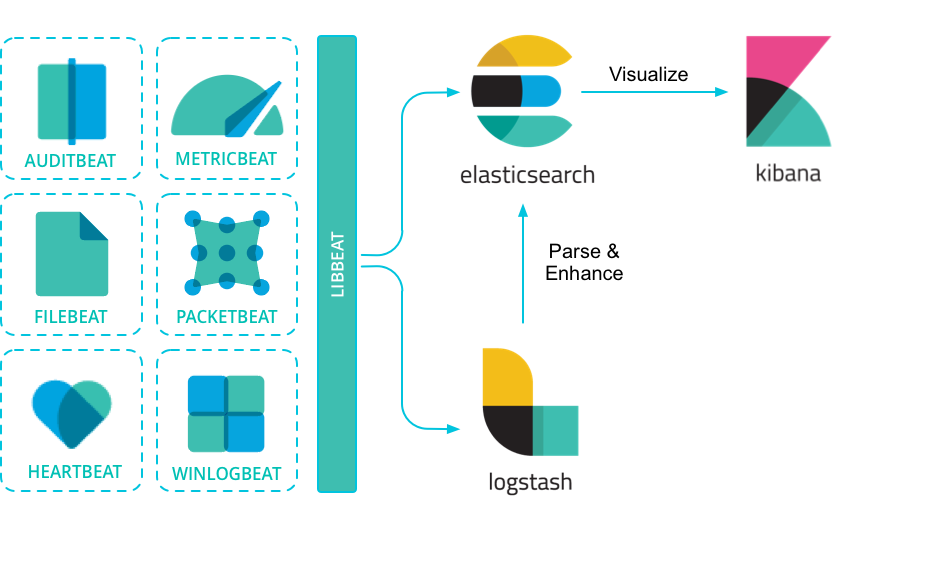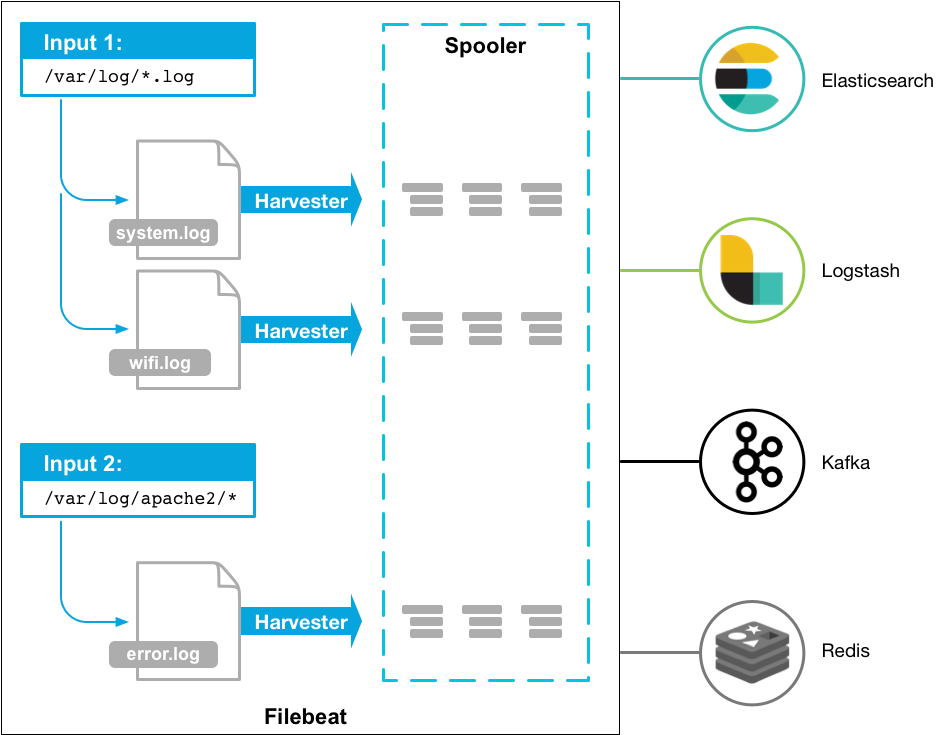---
title: Elastic 技术栈之 Filebeat
date: 2017-01-03
categories:
- javatool
tags:
- java
- javatool
- log
- elastic
---
# Elastic 技术栈之 Filebeat
## 简介
Beats 是安装在服务器上的数据中转代理。
Beats 可以将数据直接传输到 Elasticsearch 或传输到 Logstash 。
Beats 有多种类型,可以根据实际应用需要选择合适的类型。
常用的类型有:
- **Packetbeat:**网络数据包分析器,提供有关您的应用程序服务器之间交换的事务的信息。
- **Filebeat:**从您的服务器发送日志文件。
- **Metricbeat:**是一个服务器监视代理程序,它定期从服务器上运行的操作系统和服务收集指标。
- **Winlogbeat:**提供Windows事件日志。
> **参考**
>
> 更多 Beats 类型可以参考:[community-beats](https://www.elastic.co/guide/en/beats/libbeat/current/community-beats.html)
>
> **说明**
>
> 由于本人工作中只应用了 FileBeat,所以后面内容仅介绍 FileBeat 。
### FileBeat 的作用
相比 Logstash,FileBeat 更加轻量化。
在任何环境下,应用程序都有停机的可能性。 Filebeat 读取并转发日志行,如果中断,则会记住所有事件恢复联机状态时所在位置。
Filebeat带有内部模块(auditd,Apache,Nginx,System和MySQL),可通过一个指定命令来简化通用日志格式的收集,解析和可视化。
FileBeat 不会让你的管道超负荷。FileBeat 如果是向 Logstash 传输数据,当 Logstash 忙于处理数据,会通知 FileBeat 放慢读取速度。一旦拥塞得到解决,FileBeat 将恢复到原来的速度并继续传播。
## 安装
Unix / Linux 系统建议使用下面方式安装,因为比较通用。
```
wget https://artifacts.elastic.co/downloads/beats/filebeat/filebeat-6.1.1-linux-x86_64.tar.gz
tar -zxf filebeat-6.1.1-linux-x86_64.tar.gz
```
> **参考**
>
> 更多内容可以参考:[filebeat-installation](https://www.elastic.co/guide/en/beats/filebeat/current/filebeat-installation.html)
## 配置
### 配置文件
首先,需要知道的是:`filebeat.yml` 是 filebeat 的配置文件。配置文件的路径会因为你安装方式的不同而变化。
Beat 所有系列产品的配置文件都基于 [YAML](http://www.yaml.org/) 格式,FileBeat 当然也不例外。
filebeat.yml 部分配置示例:
```yaml
filebeat:
prospectors:
- type: log
paths:
- /var/log/*.log
multiline:
pattern: '^['
match: after
```
> **参考**
>
> 更多 filebeat 配置内容可以参考:[配置 filebeat](https://www.elastic.co/guide/en/beats/filebeat/current/configuring-howto-filebeat.html)
>
> 更多 filebeat.yml 文件格式内容可以参考:[filebeat.yml 文件格式](https://www.elastic.co/guide/en/beats/libbeat/6.1/config-file-format.html)
### 重要配置项
#### filebeat.prospectors
(文件监视器)用于指定需要关注的文件。
**示例**
```yaml
filebeat.prospectors:
- type: log
enabled: true
paths:
- /var/log/*.log
```
#### output.elasticsearch
如果你希望使用 filebeat 直接向 elasticsearch 输出数据,需要配置 output.elasticsearch 。
**示例**
```yaml
output.elasticsearch:
hosts: ["192.168.1.42:9200"]
```
#### output.logstash
如果你希望使用 filebeat 向 logstash输出数据,然后由 logstash 再向elasticsearch 输出数据,需要配置 output.logstash。
> **注意**
>
> 相比于向 elasticsearch 输出数据,个人更推荐向 logstash 输出数据。
>
> 因为 logstash 和 filebeat 一起工作时,如果 logstash 忙于处理数据,会通知 FileBeat 放慢读取速度。一旦拥塞得到解决,FileBeat 将恢复到原来的速度并继续传播。这样,可以减少管道超负荷的情况。
**示例**
```yaml
output.logstash:
hosts: ["127.0.0.1:5044"]
```
此外,还需要在 logstash 的配置文件(如 logstash.conf)中指定 beats input 插件:
```yaml
input {
beats {
port => 5044 # 此端口需要与 filebeat.yml 中的端口相同
}
}
# The filter part of this file is commented out to indicate that it is
# optional.
# filter {
#
# }
output {
elasticsearch {
hosts => "localhost:9200"
manage_template => false
index => "%{[@metadata][beat]}-%{[@metadata][version]}-%{+YYYY.MM.dd}"
document_type => "%{[@metadata][type]}"
}
}
```
#### setup.kibana
如果打算使用 Filebeat 提供的 Kibana 仪表板,需要配置 setup.kibana 。
**示例**
```yaml
setup.kibana:
host: "localhost:5601"
```
#### setup.template.settings
在 Elasticsearch 中,[索引模板](https://www.elastic.co/guide/en/elasticsearch/reference/6.1/indices-templates.html)用于定义设置和映射,以确定如何分析字段。
在 Filebeat 中,setup.template.settings 用于配置索引模板。
Filebeat 推荐的索引模板文件由 Filebeat 软件包安装。如果您接受 filebeat.yml 配置文件中的默认配置,Filebeat在成功连接到 Elasticsearch 后自动加载模板。
您可以通过在 Filebeat 配置文件中配置模板加载选项来禁用自动模板加载,或加载自己的模板。您还可以设置选项来更改索引和索引模板的名称。
> **参考**
>
> 更多内容可以参考:[filebeat-template](https://www.elastic.co/guide/en/beats/filebeat/current/filebeat-template.html)
>
> **说明**
>
> 如无必要,使用 Filebeat 配置文件中的默认索引模板即可。
#### setup.dashboards
Filebeat 附带了示例 Kibana 仪表板。在使用仪表板之前,您需要创建索引模式 `filebeat- *`,并将仪表板加载到Kibana 中。为此,您可以运行 `setup` 命令或在 `filebeat.yml` 配置文件中配置仪表板加载。
为了在 Kibana 中加载 Filebeat 的仪表盘,需要在 `filebeat.yml` 配置中启动开关:
```
setup.dashboards.enabled: true
```
> **参考**
>
> 更多内容可以参考:[configuration-dashboards](https://www.elastic.co/guide/en/beats/filebeat/current/configuration-dashboards.html)
>
## 命令
filebeat 提供了一系列命令来完成各种功能。
执行命令方式:
```bash
./filebeat COMMAND
```
> **参考**
>
> 更多内容可以参考:[command-line-options](https://www.elastic.co/guide/en/beats/filebeat/current/command-line-options.html)
>
> **说明**
>
> 个人认为命令行没有必要一一掌握,因为绝大部分功能都可以通过配置来完成。且通过命令行指定功能这种方式要求每次输入同样参数,不利于固化启动方式。
>
> 最重要的当然是启动命令 run 了。
>
> **示例** 指定配置文件启动
>
> ```bash
> ./filebeat run -e -c filebeat.yml -d "publish"
> ./filebeat -e -c filebeat.yml -d "publish" # run 可以省略
> ```
## 模块
Filebeat 提供了一套预构建的模块,让您可以快速实施和部署日志监视解决方案,并附带示例仪表板和数据可视化。这些模块支持常见的日志格式,例如Nginx,Apache2和MySQL 等。
### 运行模块的步骤
- 配置 elasticsearch 和 kibana
```
output.elasticsearch:
hosts: ["myEShost:9200"]
username: "elastic"
password: "elastic"
setup.kibana:
host: "mykibanahost:5601"
username: "elastic"
password: "elastic
```
> username 和 password 是可选的,如果不需要认证则不填。
- 初始化环境
执行下面命令,filebeat 会加载推荐索引模板。
```
./filebeat setup -e
```
- 指定模块
执行下面命令,指定希望加载的模块。
```
./filebeat -e --modules system,nginx,mysql
```
> **参考**
>
> 更多内容可以参考: [配置 filebeat 模块](https://www.elastic.co/guide/en/beats/filebeat/current/configuration-filebeat-modules.html) | [filebeat 支持模块](https://www.elastic.co/guide/en/beats/filebeat/current/filebeat-modules.html)
## 原理
Filebeat 有两个主要组件:
harvester:负责读取一个文件的内容。它会逐行读取文件内容,并将内容发送到输出目的地。
prospector:负责管理 harvester 并找到所有需要读取的文件源。比如类型是日志,prospector 就会遍历制定路径下的所有匹配要求的文件。
```yaml
filebeat.prospectors:
- type: log
paths:
- /var/log/*.log
- /var/path2/*.log
```
Filebeat保持每个文件的状态,并经常刷新注册表文件中的磁盘状态。状态用于记住 harvester 正在读取的最后偏移量,并确保发送所有日志行。
Filebeat 将每个事件的传递状态存储在注册表文件中。所以它能保证事件至少传递一次到配置的输出,没有数据丢失。
## 资料
[Beats 官方文档](https://www.elastic.co/guide/en/beats/libbeat/current/index.html)


